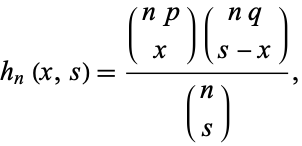
Hypergeometric Distribution
 المؤلف:
Beyer, W. H.
المؤلف:
Beyer, W. H.
 المصدر:
CRC Standard Mathematical Tables, 28th ed. Boca Raton, FL: CRC Press
المصدر:
CRC Standard Mathematical Tables, 28th ed. Boca Raton, FL: CRC Press
 الجزء والصفحة:
...
الجزء والصفحة:
...
 18-4-2021
18-4-2021
 1918
1918
Hypergeometric Distribution
Let there be  ways for a "good" selection and
ways for a "good" selection and  ways for a "bad" selection out of a total of
ways for a "bad" selection out of a total of  possibilities. Take
possibilities. Take  samples and let
samples and let  equal 1 if selection
equal 1 if selection  is successful and 0 if it is not. Let
is successful and 0 if it is not. Let  be the total number of successful selections,
be the total number of successful selections,
 |
(1)
|
The probability of  successful selections is then
successful selections is then
The hypergeometric distribution is implemented in the Wolfram Language as HypergeometricDistribution[N, n, m+n].
The problem of finding the probability of such a picking problem is sometimes called the "urn problem," since it asks for the probability that  out of
out of  balls drawn are "good" from an urn that contains
balls drawn are "good" from an urn that contains  "good" balls and
"good" balls and  "bad" balls. It therefore also describes the probability of obtaining exactly
"bad" balls. It therefore also describes the probability of obtaining exactly  correct balls in a pick-
correct balls in a pick- lottery from a reservoir of
lottery from a reservoir of  balls (of which
balls (of which  are "good" and
are "good" and  are "bad"). For example, for
are "bad"). For example, for  and
and  , the probabilities of obtaining
, the probabilities of obtaining  correct balls are given in the following table.
correct balls are given in the following table.
| number correct |
probability |
odds |
| 0 |
0.3048 |
2.280:1 |
| 1 |
0.4390 |
1.278:1 |
| 2 |
0.2110 |
3.738:1 |
| 3 |
0.04169 |
22.99:1 |
| 4 |
0.003350 |
297.5:1 |
| 5 |
 |
10820:1 |
| 6 |
 |
 |
The  th selection has an equal likelihood of being in any trial, so the fraction of acceptable selections
th selection has an equal likelihood of being in any trial, so the fraction of acceptable selections  is
is
 |
(5)
|
i.e.,
 |
(6)
|
The expectation value of  is therefore simply
is therefore simply
This can also be computed by direct summation as
The variance is
 |
(13)
|
Since  is a Bernoulli variable,
is a Bernoulli variable,
so
 |
(19)
|
For  , the covariance is
, the covariance is
 |
(20)
|
The probability that both  and
and  are successful for
are successful for  is
is
But since  and
and  are random Bernoulli variables (each 0 or 1), their product is also a Bernoulli variable. In order for
are random Bernoulli variables (each 0 or 1), their product is also a Bernoulli variable. In order for  to be 1, both
to be 1, both  and
and  must be 1,
must be 1,
Combining (26) with
gives
There are a total of  terms in a double summation over
terms in a double summation over  . However,
. However,  for
for  of these, so there are a total of
of these, so there are a total of  terms in the covariance summation
terms in the covariance summation
 |
(31)
|
Combining equations (◇), (◇), (◇), and (◇) gives the variance
so the final result is
 |
(34)
|
and, since
 |
(35)
|
and
 |
(36)
|
we have
This can also be computed directly from the sum
The skewness is
and the kurtosis excess is given by a complicated expression.
The generating function is
 |
(44)
|
where  is the hypergeometric function.
is the hypergeometric function.
If the hypergeometric distribution is written
 |
(45)
|
then
 |
(46)
|
where  is a constant.
is a constant.
REFERENCES:
Beyer, W. H. CRC Standard Mathematical Tables, 28th ed. Boca Raton, FL: CRC Press, pp. 532-533, 1987.
Feller, W. "The Hypergeometric Series." §2.6 in An Introduction to Probability Theory and Its Applications, Vol. 1, 3rd ed. New York: Wiley, pp. 41-45, 1968.
Spiegel, M. R. Theory and Problems of Probability and Statistics. New York: McGraw-Hill, pp. 113-114, 1992.
 الاكثر قراءة في الاحتمالات و الاحصاء
الاكثر قراءة في الاحتمالات و الاحصاء
 اخر الاخبار
اخر الاخبار
اخبار العتبة العباسية المقدسة


